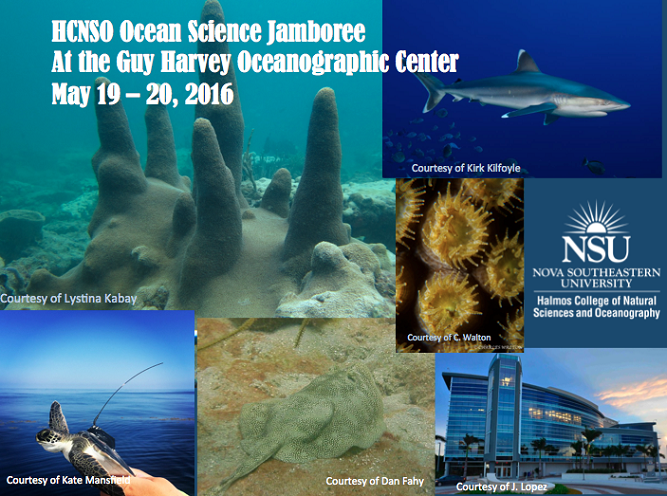Time-series observations of crinoid assemblages on a deep tropical island slope, Isla Roatán, Honduras
Location
Guy Harvey Oceanographic Center Facility
Start
5-20-2016 1:30 PM
End
5-20-2016 1:45 PM
Abstract
Video, still photographs, and specimens were collected from submersible Idabel at approximately 16°18´N, 86°36´W off Half Moon Bay on the deep western margin of Isla Roatán, Islas de la Bahía, Honduras, Central America, during 17 dives: 2012 (3 dives), 2013 (7), 2014 (4), and 2015 (3). Externally mounted scaling lasers 10 cm apart permitted measurements of crinoid size and distribution. Taxa investigated included representatives of three orders: Isocrinida - Cenocrinus asterius and Endoxocrinus carolinae (both Isselicrinidae); Comatulida - Crinometra brevipinna (Charitometridae), Neocomatella pulchella (Comatulidae), and Democrinus brevis (Bourgueticrinidae), and Cyrtocrinida - Holopus mikihe and Cyathidium pourtalesi (both Holopodidae). Mean regeneration rate of two rays of one H. mikihe was approximated from images as 5-7 mm y-1 (10-13% y-1) (although regeneration must have begun after the initial observation), giving an estimated 7-10 years for complete regeneration. No recruitment or mortality was observed for either H. mikihe or C. pourtalesi, and aggregations of evenly-sized individuals were prevalent, consistent with sporadic local recruitment and mortality. Images of the same hexactinellid sponge over the 3-year period ostensibly show the same cluster of crinoids: 9 E. carolinae, 4 C. brevipinna, and 2 N.pulchella, indicating long-term site fidelity. All three species are able to crawl. In a population sample of 372 D. brevis, 25 were entirely missing crowns; their still erect stalks suggest recent loss. Numerous specimens had injured or regenerating arms, most likely the result of predation by fishes. A specimen of D. brevis knocked over to a prostrate position by the sub was partly erect on a subsequent dive, indicating that its stalk tissues, supposedly entirely ligamentary, definitely have a contractile property. A C. asterius observed at a depth of 140 m is the shallowest record for a stalked crinoid in the tropical western Atlantic. About 80% of the 56 specimens observed occurred within a surprisingly narrow depth range of 146-159 m (with a single record at 192 m).
Time-series observations of crinoid assemblages on a deep tropical island slope, Isla Roatán, Honduras
Guy Harvey Oceanographic Center Facility
Video, still photographs, and specimens were collected from submersible Idabel at approximately 16°18´N, 86°36´W off Half Moon Bay on the deep western margin of Isla Roatán, Islas de la Bahía, Honduras, Central America, during 17 dives: 2012 (3 dives), 2013 (7), 2014 (4), and 2015 (3). Externally mounted scaling lasers 10 cm apart permitted measurements of crinoid size and distribution. Taxa investigated included representatives of three orders: Isocrinida - Cenocrinus asterius and Endoxocrinus carolinae (both Isselicrinidae); Comatulida - Crinometra brevipinna (Charitometridae), Neocomatella pulchella (Comatulidae), and Democrinus brevis (Bourgueticrinidae), and Cyrtocrinida - Holopus mikihe and Cyathidium pourtalesi (both Holopodidae). Mean regeneration rate of two rays of one H. mikihe was approximated from images as 5-7 mm y-1 (10-13% y-1) (although regeneration must have begun after the initial observation), giving an estimated 7-10 years for complete regeneration. No recruitment or mortality was observed for either H. mikihe or C. pourtalesi, and aggregations of evenly-sized individuals were prevalent, consistent with sporadic local recruitment and mortality. Images of the same hexactinellid sponge over the 3-year period ostensibly show the same cluster of crinoids: 9 E. carolinae, 4 C. brevipinna, and 2 N.pulchella, indicating long-term site fidelity. All three species are able to crawl. In a population sample of 372 D. brevis, 25 were entirely missing crowns; their still erect stalks suggest recent loss. Numerous specimens had injured or regenerating arms, most likely the result of predation by fishes. A specimen of D. brevis knocked over to a prostrate position by the sub was partly erect on a subsequent dive, indicating that its stalk tissues, supposedly entirely ligamentary, definitely have a contractile property. A C. asterius observed at a depth of 140 m is the shallowest record for a stalked crinoid in the tropical western Atlantic. About 80% of the 56 specimens observed occurred within a surprisingly narrow depth range of 146-159 m (with a single record at 192 m).


